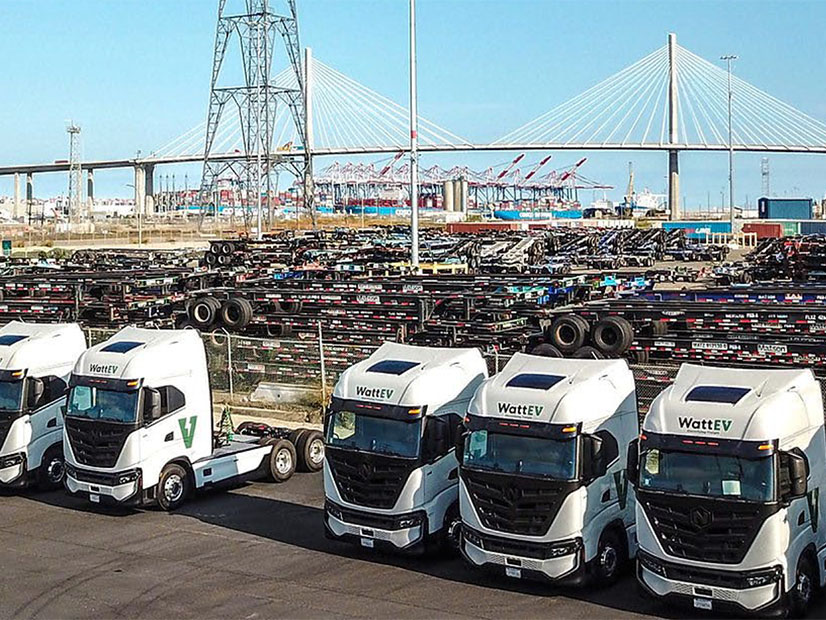
Environmental groups are urging the California Energy Commission (CEC) to use the state’s remaining $233 million in National Electric Vehicle Infrastructure (NEVI) funds to build chargers for the surge of electric trucks expected in the next decade, citing “immense public health and environmental justice benefits” for communities with poor air quality.
“As we know, the transportation sector accounts for half of the greenhouse gas emissions in California when you include upstream refining,” Jim McKinney, manager of the CEC’s fuels and transportation division, said during the agency’s May 10 NEVI workshop. “Our state’s one million trucks represent just 3% of the total vehicle fleet of 30 million vehicles, but they account disproportionately for one-third of mobile source NOx [nitrous oxide emissions], one-quarter of mobile source GHGs, and nearly three-quarters of the known cancer risk from toxic air contaminants.”
Funded by the federal Infrastructure Investment and Jobs Act, the NEVI program encourages EV uptake by developing a national network of 500,000 direct current (DC) fast chargers using $5 billion in funding to states allocated over five years. California’s share of the funding is $384 million. (See Calif. Looks to Streamline Process for Issuing NEVI Funds.)
The state’s first NEVI solicitation, issued in October 2023, offered $40.5 million to six “alternative fuel corridor” groups designated for charger development. Awards are expected to be announced this month. The second tranche of funding will provide an estimated $110.2 million to the 17 remaining corridor groups to build 598 charging ports. Applications for that round of funds are due in November.
‘Parade of Terribles’
McKinney referred to the impact of emissions from the trucking sector as “the parade of terribles” for California air quality and said the CEC is working to determine whether NEVI funds can be used for truck charging. Earthjustice called attention to the issue in comments submitted to the CEC regarding the NEVI plan in 2023.
“We recommend NEVI formula funds be allocated for medium- and heavy-duty charging in a significant way, including deployment of $50 million in Years 2 and 3 ($100 million total) to help supercharge efforts to build out charging for medium- and heavy-duty vehicles,” Earthjustice wrote.
The Greenlining Institute, an Oakland-based non-profit organization, also commented on the NEVI plan, calling attention to the importance of equity in transportation electrification.
“To date, electric vehicle charging investments have historically been deployed in well-resourced, early-adopter, higher-income census tracts or ‘low-hanging fruit’ areas. Through a profit-driven deployment strategy, low-income communities of color are being left behind while continuing to face disproportionate pollution burdens,” The Greenlining Institute wrote. “If done correctly, the administration can capitalize on this opportunity to deploy charging infrastructure in communities affected first and worst by climate impacts, align with Justice40 goals, reach the IIJA goal of 500,000 new chargers by 2030.”
Guidance and regulations from the federal Joint Office of Energy and Transportation say the primary purpose of NEVI is to build light-duty fast-charge stations. However, funds can be shifted to other uses when alternative fuel corridors are “built out,” the presentation reads.
“One key challenge is that there are no nationally defined or agreed-upon standards for truck-charging connectors, charging power levels, station power, station configuration or amenities,” McKinney said.
The CEC has asked the Joint Office for clarification on whether NEVI funds can be used for truck charging, and while the agency hasn’t received confirmation, charging and fueling infrastructure grants were used to build charging stations for trucks in the past, so it knows “it’s possible,” he said.
The demand for EV truck chargers is growing. As part of AB 2127, the CEC publishes a biennial report assessing the EV charging infrastructure needed to meet the state’s goals of putting at least 5 million zero-emission vehicles on the road by 2030. The CEC expanded this year’s report to include modeling forecasts for heavy-duty charging and projected the need for 114,500 chargers to support 155,000 zero-emission trucks by 2030.
“This is an immense need, especially considering how few operational truck chargers we now have in California,” McKinney said.


